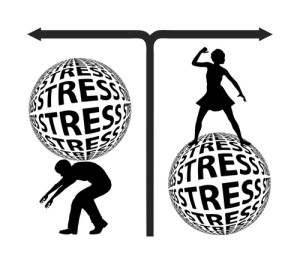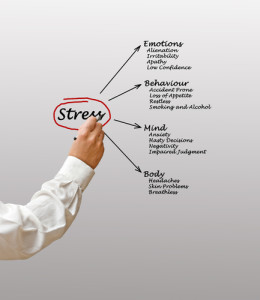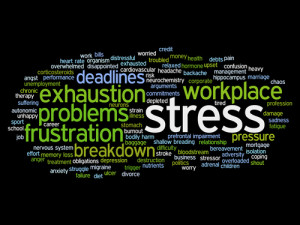ONE NATION UNDER STRESS, OR, CAN A CAVEMAN SURVIVE IN MODERN SOCIETY?
 Stress is a “fact of life” for 80% of Americans, and, 73% believe that stress is “impacting their health”, according to the American Psychological Association, writing in their 2007 article, Stress in America. 50% also believe stress is having a “negative impact on their emotional health.” Worry, frustration, resentment, loneliness, anxiety and depression litter the landscapes of our minds as commonly as streets, fast food stores, and gas stations do in our outer world.
Stress is a “fact of life” for 80% of Americans, and, 73% believe that stress is “impacting their health”, according to the American Psychological Association, writing in their 2007 article, Stress in America. 50% also believe stress is having a “negative impact on their emotional health.” Worry, frustration, resentment, loneliness, anxiety and depression litter the landscapes of our minds as commonly as streets, fast food stores, and gas stations do in our outer world.
60% of us have one or more chronic diseases and stress is a prominent factor in all of them. Alcohol, cigarettes, eating sweets, working harder, tranquilizers, running, and sleeping help a bit, but there seems to be no off-switch for the worry and frustration that intrudes into our minds like a barking dog in the night.
Who is in control of our thoughts? Where do these thoughts come from? These are the questions that lead to the resolution of stress and the highest level of healing, which is self-knowledge.
In order to understand the nature of stress, we need to review how our bodies are wired for survival.
How Our Bodies Respond to Stress
For the past 20,000 years, mankind has responded to stress in the same way. Whenever we perceive, or imagine, something to be dangerous, the sympathetic nervous system ignites the fight/flight system to prepare us to meet the challenge.
The powerful hormones adrenaline and cortisol course through our bodies and within seconds we are ready for action with tight muscles, rapid heartbeat, elevated blood pressure, and slower digestion.
Blood is diverted from our gut to our brains, and our hands become cool and clammy. Breathing becomes rapid and shallow to increase oxygen levels in the body. Our liver pours glucose, i.e. sugar, into the blood to provide the necessary fuel for active muscles. White blood cells increase in the blood, equipping the immune system to combat any potential infection. Blood-clotting factors are released in case of injury. Our senses are heightened and we begin to perspire.
 The key issue is that stress system is designed to prepare us for physical action that our life may depend upon such as fighting or escaping (thus the name “fight-or-flight.”) For primitive people, this worked really well since they faced frequent physical challenges that were resolved one way or the other fairly quickly. But few of us today need to evade lions in African savannas, hunt buffalo on the plains, or raid neighboring villages for food.
The key issue is that stress system is designed to prepare us for physical action that our life may depend upon such as fighting or escaping (thus the name “fight-or-flight.”) For primitive people, this worked really well since they faced frequent physical challenges that were resolved one way or the other fairly quickly. But few of us today need to evade lions in African savannas, hunt buffalo on the plains, or raid neighboring villages for food.
Our modern society largely protects us from the dangers of the outside world. Our stresses are mostly inner challenges that usually can’t be resolved with physical action. In these cases, the physical arousal of the fight-flight system serves no purpose.
When Dangers Are Within
Basically the nature of our stresses has changed dramatically since our hunter/gatherer days, but our DNA driven stress system has not. Few would argue that contemporary life is easy just because the lions and tigers are out of the picture. In fact, most people seem to feel that life today is getting more and more stressful all the time.
We don’t have to hunt for our food but we do have to pay for it at the supermarket. We also have other bills to pay including house payments or rent, utilities, car payments, furniture, college educations for our kids, cable TV, Internet providers – the list seems to grow every year because there’s more and more that we supposedly can’t do without.
It is imperative that we succeed at work just to make ends meet, yet the ever more flexible, fast-changing, global economy makes our jobs insecure even when our performance is exemplary. It doesn’t help that we have to drive to those insecure jobs every day on congested roads and freeways. And that all that traffic just eats up more hours in a day that was already woefully short for all that we had to crowd into it.
When we get home from work, we turn on the television newscast and hear about various crises – global warming, collapsing economies in other countries that are linked to our own, rogue nations with dangerous weapons – that threaten us in some vague way but are too massive and complex for us ever to resolve even if we dedicate our lives to it. For many of us, the delicate state of our personal relationships seem, to our minds anyway, to threaten our survival, too. Yet, we can no more solve those problems in any final way than we can end tensions in the Middle East.
There is no doubt as to the proper course of action for a caveman facing a saber-tooth tiger — he flees or he dies. His stress system serves him well. It prepares him to run away, and if he is fortunate enough to escape, he will then rest while his parasympathetic system returns his aroused system to normal.
But in the absence of tigers and other physical threats, the stress system backfires. Consider financial or relationship worries, for example. Even if we take action steps from the beginning, the crisis will probably persist for some time. Yet the fight/flight stress system is the same as it was for cave dwellers millions of years ago. It readies our bodies for physical action — our muscles tense, we get red as our blood pressure rises, our stomach churns, our heart pounds, and our hands become sweaty.
If there’s no appropriate physical action for situation, it may take hours or even days for the body to dissipate the aroused state. In the meantime, we sort of stew in our own juices.
 In the short term, emotional stresses can cause a headache, upset stomach, or heart palpitations. If similar stresses recur regularly, they can lead to chronic diseases like high blood pressure, ulcers, and heart disease.
In the short term, emotional stresses can cause a headache, upset stomach, or heart palpitations. If similar stresses recur regularly, they can lead to chronic diseases like high blood pressure, ulcers, and heart disease.
Hypertension, alcoholism, drug abuse, fatigue, and depression are just a few of the other common ailments attributed in part to chronic stress. Medical textbooks state that 90% of all illnesses are due to stress or other mind/body factors. Chronic stress is also a major contributor to the development of cancer.
In short then, our magnificent stress system seems to have become obsolete. Instead of helping us succeed in the face of danger, it now interferes because our challenges have become so vague and complex.
Chronic stress in the body is like constantly revving the engine of a Ferrari in the driveway without ever taking it out on the highway. Unable to mechanically “let go,” the car begins to break down. Similarly, chronic stress that is not released wears down the body, and can lead to psychosomatic disease. (“Psychosomatic” does not mean “imagined” or “not real.” It simply signifies medicine’s acknowledgment that many bodily illnesses have origins in psychological states.)
It’s intriguing to note that primitive people who live much as prehistoric humans did – for instance, the inhabitants of the African Kalahari or the Australian aborigines living in the outback — don’t suffer stress-related diseases. They don’t have high blood pressure, heart attacks, ulcers or cancer.
So, what can we do about this profound evolutionary paradox?
To explore this important issue, let’s look again at the mind/body anatomy of the fight or flight system.
The “on-switch” for the stress system is a tiny patch of brain tissue called the hypothalamus, located in the center of the brain. The hypothalamus controls and regulates the entire autonomic nervous system including, of course, the sympathetic branch.
The hypothalamus, as the name implies, sits just below the thalamus, a small and mysterious organ that in turn sits just beneath the cerebral cortex, the thinking center of the brain. The thalamus receives information – other than smells — from the body’s sensory organs. It then relays this input to the cerebral cortex. This sensory information constitutes our awareness of the world around us. We use it in thinking and in responding to the sensory input.
The hypothalamus is the command center for many primary body functions including hormonal balance, appetite and food intake, and sexual function as well as complex motivational states such as fatigue, hunger, anger, and placidity. Effectively, it is the emotional headquarters of the brain, and also harmonizes the behaviors associated with emotional states.
“Wired” to the hypothalamus, the brain stem and spinal cord below it extend into the body like the trunk of an inverted tree, with branches reaching downward into every part of the human system. Emotions spark the hypothalamus to “electrify” our feelings through the autonomic nervous system into the familiar bodily sensations of emotional arousal.
Emotions may be the most obvious proof that mind and body are one because while we think of emotions as occurring in our minds, they are in fact total body experiences. Emotions have many variations and names. But if we distill them down, they all relate to the primary, and polar, emotions of love and fear.
Love encompasses the experiences of compassion, fondness, happiness, joy, among many other positive states. The derivatives of fear include anger, resentment, frustration, worry, and anxiety, among many others. When received from someone or given to others, love has the power to heal the body. It is also a lifeblood emotion – an infant denied love may fail to thrive or even die.
To understand how emotions do harm means understanding fear and its derivatives, and in particular the fears that are common in contemporary life. Fears trip the fight-or-flight switch in the hypothalamus. That’s fine for a cave person or a modern rock climber. One way or another, that fear will soon be expressed and released and in the meantime it can heighten awareness, prepare the person for quicker responses, and otherwise help ensure survival.
 But modern stresses, as we’ve seen, aren’t so easily resolved, so they just build up in us as a background condition of our lives. What makes matters worse is that our society hasn’t prepared us to deal with emotional issues in a way that could lighten this stress load.
But modern stresses, as we’ve seen, aren’t so easily resolved, so they just build up in us as a background condition of our lives. What makes matters worse is that our society hasn’t prepared us to deal with emotional issues in a way that could lighten this stress load.
Society teaches us intellectual skills but not emotional ones, so few of us have ever learned how to allow our emotions to express themselves in a way that would lighten this background stress load.
Indeed, we’ve been told that the answer is Tylenol for our stress-related headaches, Tums for our emotionally upset stomachs, or prescription drugs for our emotionally caused high blood pressure.
To prevent stress-related illness – and because chronic stress compromises the immune system, we may be talking about most illness to some degree or another – we have to get that fight/flight switch turned off for stresses not connected to our immediate survival. How do we that? We start by properly interpreting stress.
Using Stress as Your Guide and Teacher
The proper interpretation of danger, or stress, for the individual personality is one of the most skills that we can develop and is a key feature of my book, Edgework, Exploring the Psychology of Disease. In fact, Edgework completely redefines stress so that the physical signs of stress that you feel as you experience a challenging or threatening situation become signals for inner exploration and increased self-understanding.
Instead of just living with stress in the body and then seeking to reduce its troublesome symptoms later, you can turn it to your advantage by learning from it.
In essence, the secret is to embrace stress as an opportunity to understand how you create it for yourself. It becomes the marker for personal psychological exploration and a building block in the most rewarding educational endeavor you’ll ever undertake – the pursuit of self-knowledge.
Now, your stress system is no longer obsolete. More importantly, it’s no longer the relentless generator of stress-related illness. Instead, it is your internal ally, reminding you to inquire within and understand yourself better.

